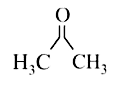CH3−CH=CH2Cl2/H2O−−−−−→
The correct product is

CH3−CH|Cl−CH∣Cl2

H3C−CH| OH−CH|Cl2
The correct Answer is:D
To solve the question regarding the reaction of propene (CH₃-CH=CH₂) with chlorine (Cl₂) and water (H₂O), we will follow the steps of the reaction mechanism:
1. Identify the Reactants:
The reactants are propene (CH₃-CH=CH₂) and the reagents Cl₂ and H₂O.
2. Formation of Cyclic Halonium Ion:
When Cl₂ is added to the double bond of propene, one of the chlorine atoms forms a bond with one of the carbon atoms in the double bond. This results in the formation of a cyclic halonium ion. The structure can be represented as:
CH3−C+(Cl)−CH2
Here, the positive charge is on the carbon that is bonded to the chlorine atom.
Hint: Look for the formation of a cyclic structure when halogens add to alkenes.
3. Nucleophilic Attack by Water:
Water (H₂O), which acts as a nucleophile, attacks the more substituted carbon of the cyclic halonium ion. The oxygen atom of water donates a pair of electrons to form a bond with the positively charged carbon, leading to the opening of the cyclic structure.
4. Formation of Alcohol:
The product formed after the nucleophilic attack is a chlorohydrin. The structure can be represented as:
CH3−C(OH)−CH2Cl
Here, the OH group from water adds to the carbon that was not bonded to chlorine.
5. Final Product:
The final product of the reaction is 2-chloropropanol (CH₃-CHOH-CH₂Cl), where the hydroxyl group (OH) and the chlorine atom (Cl) are added to adjacent carbons.
Conclusion:
The correct product formed from the reaction of propene with Cl₂ and water is 2-chloropropanol (CH₃-CHOH-CH₂Cl).
Final Answer:
The correct product is 2-chloropropanol.
The reactants are propene (CH₃-CH=CH₂) and the reagents Cl₂ and H₂O.
When Cl₂ is added to the double bond of propene, one of the chlorine atoms forms a bond with one of the carbon atoms in the double bond. This results in the formation of a cyclic halonium ion. The structure can be represented as:
CH3−C+(Cl)−CH2
Here, the positive charge is on the carbon that is bonded to the chlorine atom.
Water (H₂O), which acts as a nucleophile, attacks the more substituted carbon of the cyclic halonium ion. The oxygen atom of water donates a pair of electrons to form a bond with the positively charged carbon, leading to the opening of the cyclic structure.
The product formed after the nucleophilic attack is a chlorohydrin. The structure can be represented as:
CH3−C(OH)−CH2Cl
Here, the OH group from water adds to the carbon that was not bonded to chlorine.
The final product of the reaction is 2-chloropropanol (CH₃-CHOH-CH₂Cl), where the hydroxyl group (OH) and the chlorine atom (Cl) are added to adjacent carbons.
The correct product formed from the reaction of propene with Cl₂ and water is 2-chloropropanol (CH₃-CHOH-CH₂Cl).
The correct product is 2-chloropropanol.
Topper's Solved these Questions
- JEE MAIN REVISION TEST- 16BOOK - VMC MODULES ENGLISHCHAPTER - JEE MAIN REVISION TEST- 16EXERCISE - CHEMISTRY (SECTION 2)
5 Videos
- JEE MAIN REVISION TEST 8 (2020)BOOK - VMC MODULES ENGLISHCHAPTER - JEE MAIN REVISION TEST 8 (2020)EXERCISE - CHEMISTRY (SECTION 2)
5 Videos
- JEE MAIN REVISION TEST- 24 BOOK - VMC MODULES ENGLISHCHAPTER - JEE MAIN REVISION TEST- 24 EXERCISE - CHEMISTRY (SECTION - 2)
5 Videos
Similar Questions
Knowledge Check
CH2=CH−CH=CH2CCl3Br−−−−→product. The major product is :
ABr−CH2−CH=CH−CH2−CCl3BCH2=CH−CH∣Br−CH2−CCl3CCH2=CH−CH∣CCl3−CH2−BrDnone is correctCH3CH=CH2NaBD4−−−−−−→H2O2/OH Product X, X is :
ACH3C∣OHHCH2DBCH3C∣DHCH2OHCCH3C∣ODHCH3Dnone is correctPh−CH=N−CH3+Ph−CH2MgClH2O−−→ major product :
APh−O∣∣C−HBPh−CH2−N∣CH2Ph−CH3CPh−CH−CH2∣H3C−NH−PhDNone of these
CH3CH3∣C∣CH3−CH=CH2+H∣H2o−−−→'P' (major) product 'P' is-
View SolutionThe number of bonds between carbon and oxygen atoms in major product of the following reaction is________.
CH3OH∣CHCH2CH2NH2ethyl formate (1 equiv)−−−−−−−−−−−−−→triethylam in e
View SolutionThe major product (Y)in the following reaction sequency is :
CH3−CH3∣CH−CH=CH2Br2/H2O−−−−−→Xconc.H2SO4/Δ−−−−−−−−−→Y
View SolutionSelect the correct statement about the following reaction
CH3−C∣CH3H−CH2−CH=CH2H2/Ni−−−→(Y)Cl2/hv−−−→Monochloro products
View SolutionCH3−CH=CH2BD3−−−−−−−→H2O2/OH−product X, X is :
View Solution
